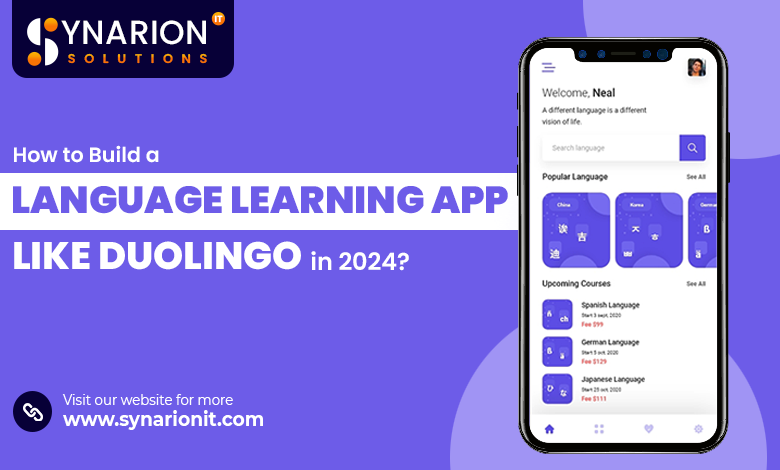How to Build a Language Learning app like Duolingo in 2024?

Introduction
In the digital age, language learning has become more accessible and engaging than ever before, thanks to the proliferation of mobile apps. Among these, Duolingo stands out as a pioneer, offering users a gamified and effective platform for mastering new languages. If you’re considering venturing into the realm of language learning app development in 2024, this comprehensive guide will walk you through the essential steps and strategies to build a successful app akin to Duolingo.
Understanding the Landscape
Before delving into the development process, it’s crucial to gain a comprehensive understanding of the language learning app market landscape. Analyze the existing competitors, identify their strengths and weaknesses, and pinpoint the gaps in the market that your app can address. Additionally, conduct thorough market research to ascertain the preferences and pain points of your target audience.
Defining Your Unique Value Proposition
To stand out in a crowded market, your language learning app must offer a unique value proposition that resonates with users. Whether it’s innovative features, personalized learning experiences, or a diverse range of languages, identify what sets your app apart from the competition and articulate it clearly to your audience.
Planning Your Language Learning App
Once you’ve defined your value proposition, it’s time to outline the key features and functionalities of your app. Drawing inspiration from successful platforms like Duolingo, consider incorporating gamification elements, progress tracking tools, interactive lessons, and social features to enhance user engagement and retention.
Choosing the Right Technology Stack
Selecting the appropriate technology stack is crucial for ensuring the scalability, performance, and security of your language learning app. Opt for robust frameworks and programming languages suited for mobile app development, such as React Native, Flutter, or Swift for iOS and Kotlin for Android. Additionally, leverage cloud-based solutions for backend development, storage, and hosting to streamline the development process and optimize resource utilization.
Designing an Intuitive User Experience
User experience (UX) design plays a pivotal role in the success of any mobile app, particularly in the competitive language learning market. Prioritize simplicity, intuitiveness, and accessibility in your app’s design, ensuring that users can navigate seamlessly through lessons, exercises, and progress tracking features. Incorporate visually appealing graphics, animations, and multimedia elements to create an engaging learning environment.
Developing Core Features and Functionalities
With the groundwork laid, it’s time to start developing the core features and functionalities of your language learning app. Here are some essential features to consider integrating:
User Authentication
Implement secure user authentication mechanisms, allowing users to create accounts, log in, and personalize their learning experiences.
Language Selection
Provide users with a diverse range of languages to choose from, catering to both beginners and advanced learners.
Interactive Lessons
Develop interactive lessons encompassing vocabulary, grammar, pronunciation, and comprehension exercises tailored to each language.
Gamification Elements
Incorporate gamification elements such as points, levels, badges, and rewards to incentivize learning and motivate users to progress.
Progress Tracking
Enable users to track their learning progress, view performance metrics, and set personalized goals to stay motivated.
Social Features
Integrate social features such as leaderboards, challenges, and language exchange forums to foster community engagement and peer learning.
Offline Mode
Provide users with the option to download lessons and content for offline access, enabling uninterrupted learning anytime, anywhere.
In-App Purchases and Subscriptions
Monetize your app through in-app purchases, subscriptions, or premium features, offering users additional content and benefits for a fee.
Testing and Quality Assurance
Before launching your language learning app, thorough testing and quality assurance are imperative to ensure a seamless user experience and identify any potential bugs or issues. Conduct comprehensive testing across various devices, platforms, and user scenarios, soliciting feedback from beta testers and incorporating necessary refinements and optimizations.
Launching and Marketing Your App
With your language learning app developed and thoroughly tested, it’s time to launch it into the market. Develop a comprehensive marketing strategy encompassing app store optimization (ASO), social media marketing, influencer collaborations, content marketing, and targeted advertising to maximize visibility and attract your target audience. Leverage analytics tools to track user engagement, retention, and feedback, iterating and optimizing your app based on real-time data and user insights.
Continued Iteration and Improvement
The launch of your language learning app is just the beginning of your journey. Continuously monitor user feedback, analyze app performance metrics, and iterate on your product to address user needs, introduce new features, and stay ahead of the competition. Embrace a culture of continuous improvement and innovation, consistently delivering value to your users and cementing your app’s position as a leader in the language learning market.
Conclusion
Building a language learning app like Duolingo in 2024 requires meticulous planning, innovative thinking, and a commitment to delivering a superior user experience. By understanding the market landscape, defining your unique value proposition, and leveraging cutting-edge technologies and design principles, you can create a compelling and successful app that empowers users to master new languages and embark on their learning journey with confidence.



